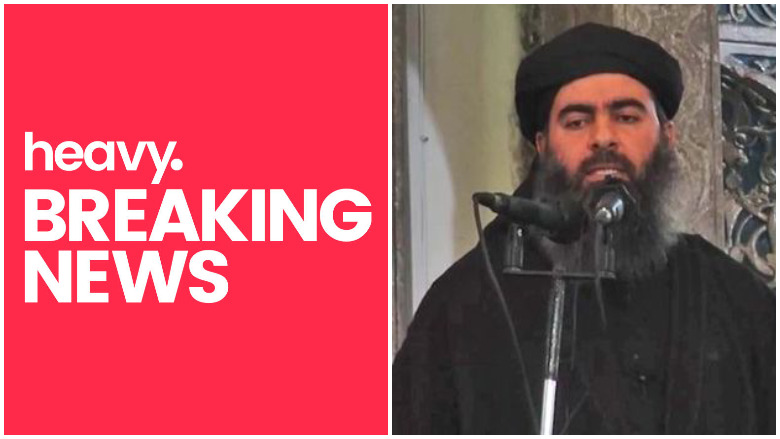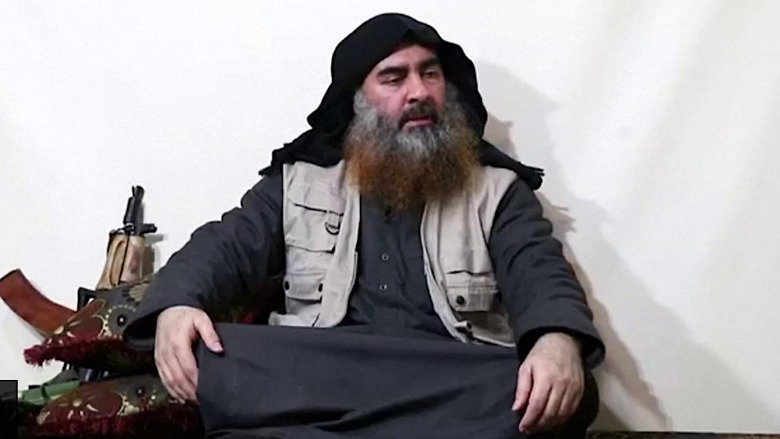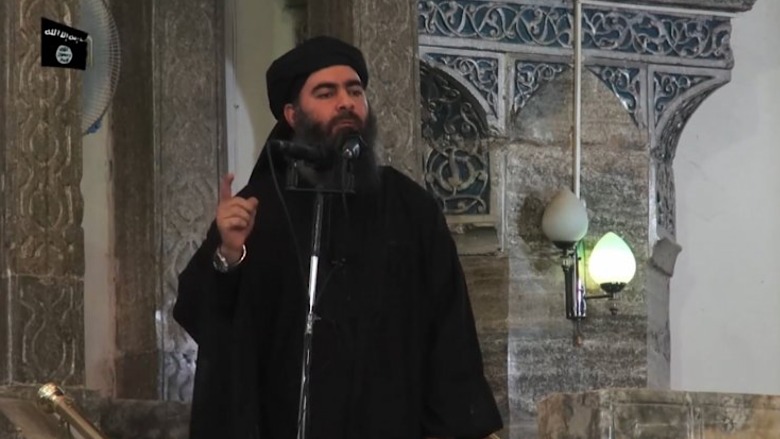
Abu Bakr al-Baghdadi, sometimes called the “invisible sheikh” because of his aversion to having his photograph taken and who grew up in an Iraqi family steeped in religious fervor, was the leader of the Islamic State, otherwise known as ISIS.
He also earned the nickname “The Believer” for his religious studies, which dated to childhood and continued in college when he began preaching at a Baghdad mosque, according to Brookings.edu. Now, the secretive leader of ISIS is dead, according to President Donald Trump. He blew himself up, along with three of his children, as U.S. forces closed in.
“Something very big has just happened!” President Donald Trump tweeted shortly before news first broke that al-Baghdadi might be dead.
On Sunday morning, Trump confirmed the mission and al-Baghdadi’s death.
“Last night the United States brought the world’s number one terrorist leader to justice. Abu Bakr al-Baghdadi is dead,” Trump said. “He was the founder and leader of ISIS. The most ruthless and violent terror organization anywhere in the world. The United States has been searching for Baghdadi for many years. Capturing or killing Baghdadi has been the top national security priority of my administration. U.S. special operation forces executed a daring and dangerous nighttime raid in northwestern Syria and accomplished their mission in grand style. The U.S. personnel were incredible, I got to watch much of it.”
Trump said al-Baghdadi’s death was confirmed using DNA at the site. No U.S. service members were killed or wounded. Trump said other members of ISIS fighters and Baghdadi’s companions were killed in the attack, but he did not specify how many. Others were taken into custody.
Here’s what you need to know about al-Baghdadi and the raid that killed him:
1. Al-Baghdadi Was Cornered in a Tunnel & Blew Himself Up, Also Killing 3 of His Children, After Being Chased by US Military Dogs While ‘Whimpering & Crying & Screaming’
President Trump said al-Baghdadi died, “after running into a dead-end tunnel, whimpering and crying and screaming all the way. The compound had been cleared by this time with people either surrendering or being shot and killed. Eleven young children were moved out of the house and are uninjured. The only ones remaining were Baghdadi in the tunnel and he had dragged three of his young children with him. They were led to certain death.”
Trump said he, “reached the end of the tunnel as our dogs chased him down. He ignited his vest, killing himself and the three children. His body was mutilated by the blast, the tunnel had caved in on it in addition. … The thug who tried so hard to intimidate others spent his last moments in utter fear, in total panic and dread, terrified of the American forces bearing down upon him.”
Trump said U.S. forces were in the compound for about two hours and were able to take highly sensitive material and information from the raid, including about ISIS’s origins and future plans.
“Baghdadi’s demise demonstrates America’s relentless pursuit of terrorist leaders,” Trump said.

Militant propoganda videoAbu Bakr al-Baghdadi
Newsweek was first to break the unconfirmed news that al-Baghdadi might be dead. The magazine reported on the evening of October 26, 2019 that the United States military “has conducted a special operations raid targeting one of its most high-value targets, Abu Bakr al-Baghdadi.”
According to Newsweek, President Trump approved the mission a week before. Newsweek reported that al-Baghdadi was dead. James LaPorta, a Newsweek staff writer, wrote on Twitter, “A reminder @Newsweek is still publishing great stories, like the scoop we published tonight about U.S. Special Operation troops killing Abu Bakr al-Baghdadi during a raid in Syria’s northwestern Idlib province.”
Katie Bo Williams, a journalist with Defense One, tweeted that “Baghdadi is believed to have detonated his suicide vest, killing himself.” The president later confirmed that.
ABC’s James Gordon Meek then tweeted, “Abu Bakr al-Baghdadi is believed to have detonated a suicide vest he was wearing when the US special mission unit carried out the ground raid in Idlib on Saturday, according to a counterterrorism official. Afterward, the building was leveled by the US operators.”
ABC’s Luis Martinez added these details: “BREAKING From @MarthaRaddatz @LMartinezABC @abc — Two US officials confirm that US Special Operations Forces conducted a raid in Syria on Saturday targeting Abu Bakr al-Baghdadi, the head of ISIS. He is believed to be dead, said the officials. Biometric confirmation underway.”
2. Al-Baghdadi, Who Was Born in Iraq to a Sunni Family, Was Known for His Piety Growing Up in a Religous Household

Militant videoAbu Bakr al-Baghdadi
Abu Bakr al-Baghdadi was born “Ibrahim Awwad Ibrahim al-Badri” in 1971 in Samarra, Iraq, according to CounterExtremism.com.
He served as ISIS’s caliph – which the site says is Arabic for “successor” – since June 2014, CounterExtremism reports. However, CNN reports that Al-Baghdadi became leader of the “Islamic State of Iraq (ISI)” in 2010. Three years later, ISI became ISIS when it merged with another militant group tied to al-Qaeda, the Cable News Network reported.
“In assuming the title, Baghdadi declared himself the religious, political, and military leader of all Muslims,” the CounterExtremism site reports.
BBC reports that al-Baghdadi was born “to a lower-middle class Sunni family” known for its “piety” and claims of “descent from the Prophet Muhammad.” NBC reported, though, that much of Baghdadi’s childhood stories are considered possibly myth.
Growing up, he was known for passionately reciting the Koran and “was meticulous in his observance of religious law,” according to BBC. Such was his religious fervor, even then, that he was nicknamed “The Believer.”
Brookings.edu described al-Baghdadi in this era as “The son of a pious man who taught Quranic recitation in a local mosque.” Al-Baghdadi was “withdrawn, taciturn, and, when he spoke, barely audible,” the site reported. The site describes how he would admonish family members if they didn’t adhere to religious teachings. He spent his childhood at school or a mosque, fervently engaged in the study of religion.
The book, Under the Black Flag: An Exclusive Insight Into the Inner Workings of ISIS, by Sami Moubayed, says that Baghdadi’s brothers included Shamsi, the eldest, who was jailed in Iraq over financial affairs and embezzlement.
“He is not a Salafi and is critical of his brother’s career path,” the book says, adding that the middle brother, Jumaa “is a fervent jihadi and currently serves as his younger brother’s private bodyguard.”
The three studied “at state-run high schools in Samarra.”
When Baghdadi was nine, many family members fought in the Iran-Iraq War, with some giving their lives. He moved to Baghdad with his family in 2989 the book says, renting a small apartment in the al-Tobaji middle class neighborhood.
His mother was a “woman from the Bodari tribe to whom the young al-Baghdadi was greatly attached,” the book says. He carried a photo of her always.
Although the family argues it’s directly descended from the Prophet Muhammad through his elder grandson Imam al-Hasan, some clerics dispute the family’s claims.
3. Al-Baghdadi Has Been Described for Years as an Isolated Commander in Hiding; He Was Married to Multiple Wives
For years, Al-Baghdadi has been characterized as an isolated figure on the run.
“U.S. and Iraqi defense officials, in their most expansive comments to date on al-Baghdadi’s fate, described an isolated commander hiding in the desert and focused largely on his own survival, a sharp contrast to the charismatic jihadi preacher who barely more than a year ago ruled a ‘caliphate’ that stretched from central Syria to the outskirts of Baghdad,” reported The Washington Times in March 2017.
According to CNN, the terrorist leader was “in hiding for the last five years.” In April 2019, a video published by ISIS showed a man who may have been Baghdadi. Before that, he was last seen publicly in 2014.
In January 2017, there were reports that al-Baghdadi had been “critically injured” in air strikes in Iraq. The ISIS leader “was said to have been wounded after a US-led coalition bombing raid in Al-Ba’aj in northern Iraq,” reported the Sun. However, he lived to see another day after that report.
In 2016, British media spread false reports that al-Baghdadi had been poisoned and was dead. That report derived from the Iraqi News agency. “The ISIS leader was poisoned alongside three of his commanders after all four consumed spiked meals in the Be’aaj district, southwest of Mosul in Iraq,” reported UK Express in 2016; if the terrorist leader was poisoned at all, he survived that account too.
Al-Baghdadi’s death would be a big deal to Coalition forces; he’s one of the world’s most wanted men with a multi-million dollar bounty on his head.
As of 2015, the Al Monitor article reported that “Baghdadi is married to two women who gave birth to his six children.” Since that article CNN reported on a third wife and seventh child.
His first wife is named Asma Fawzi Mohammed al-Kubeisi and she is his first cousin, the site reports, adding that the militant leader had these children with her: Huzaifa, Omaima, Yaman, Hasan and Fatima.
Baghdadi also has a second wife named Israa Rajab Mahal al-Qaisi, the site reported, and she is the mother of son Ali. It’s not clear whether the wives were living with him, however.
According to CNN, Saja al-Dulaimi told Sweden’s Expressen TV that she was also married to Abu Bakr al-Baghdadi and had a daughter with him. “I married a normal person, a university lecturer,” she said of the 2008 union. “He was a family man.”
4. Al-Baghdadi, Who Was Once in a U.S. Detention Camp, Was Very Secretive & Few Photographs of Him Are Known to Exist
According to CounterExtremism, al-Baghdadi has tried very hard to keep his identity under wraps. Before ISIS became a force in 2014, the site reports, only two photos of Baghdadi were known to exist, and he was often masked after that.
This earned him the moniker “invisible sheikh.”
In 2014, though, he did give a speech from the pulpit of Mosul’s Great Mosque, the site reports.
According to NBC News, he was once held in a U.S. Detention Camp called Camp Bucca in Iraq, where he was remembered as “savvy.” The television network reported that he was “active in Fallujah in the early 2000s,” commanding only up to 100 fighters, and was detained in 2005. Four years later, he was turned over to Iraqi officials and commented, “I’ll see you guys in New York,” NBC reported. It’s believed that the United States’ invasion of Iraq radicalized him.
5. The ISIS Leader Had Advanced College Degrees & Joined the Muslim Brotherhood
According to BBC, al-Baghdadi has multiple college degrees in Islamic and Koranic studies. They are a bachelor’s degree from the University of Baghdad in 1996 and a Master’s in 1999 and PhD in 2007 from Iraq’s Saddam University.
During graduate school he lived in the Tobchi neighborhood of Baghdad, BBC reported, where he taught “Koranic recitation” to children at a neighborhood mosque and played football. It was when he was in college that he joined the Muslim Brotherhood at the urging of an uncle, and “embraced Salafist jihadism,” according to BBC.
READ NEXT: The Death of Abu Bakr al-Baghdadi.

